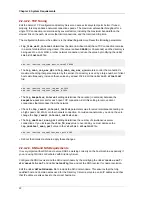
Chapter 1. Preparing for a Directory Server Installation
8
Option
Alternate Options
Description
Example
information is written to
a temporary file.
For no log file, set the
file name to
/dev/
null
:
-l /dev/null
--update
-u
This parameter
updates existing
Directory Server
instances. If an
installation is broken in
some way, this option
can be used to update
or replace missing
packages and then
re-register all of the
local instances with the
Configuration Directory.
Table 1.1. setup-ds-admin Options
1.4. Overview of Setup
After the Directory Server packages are installed, there is a script,
setup-ds-admin.pl
, which you
run to configure the new Directory Server and Administration Server instance. This script launches
an interactive setup program. The setup program supplies default configuration values which you can
accept them or substitute with alternatives. There are three kinds of setup modes, depending on what
you select when you first launch the setup program:
•
Express
— The fastest setup mode. This requires minimal interaction and uses default values for
almost all settings. Because express installation does not offer the choice of selecting the Directory
Server server port number or the directory suffix, among other settings, Red Hat recommends that
you not use it for production deployments. Also, express setups can fail if default configuration
values are not available because there is no way to offer an alternative.
•
Typical
— The default and most common setup mode. This prompts you to supply more detailed
information about the directory service, like suffix and configuration directory information, while still
proceeding quickly through the setup process.
•
Custom
— The most detailed setup mode. This provides more control over Administration Server
settings and also allows data to be imported into the Directory Server at setup, so that entries are
already populated in the databases when the setup is complete.
The information requested with the setup process is described in
Table 1.2, “Comparison of Setup
Types”
.
There is a fourth setup option,
silent setup
, which uses a configuration file and command-line options
to supply the Directory Server settings automatically, so there is no user interaction required. It is also
possible to pass setup arguments with the script, as described in
Section 1.3, “About the setup-ds-
admin.pl Script”
. The possible
.inf
setup file parameters are listed and described in
Section 6.3.5,
“About .inf File Parameters”
.
















































